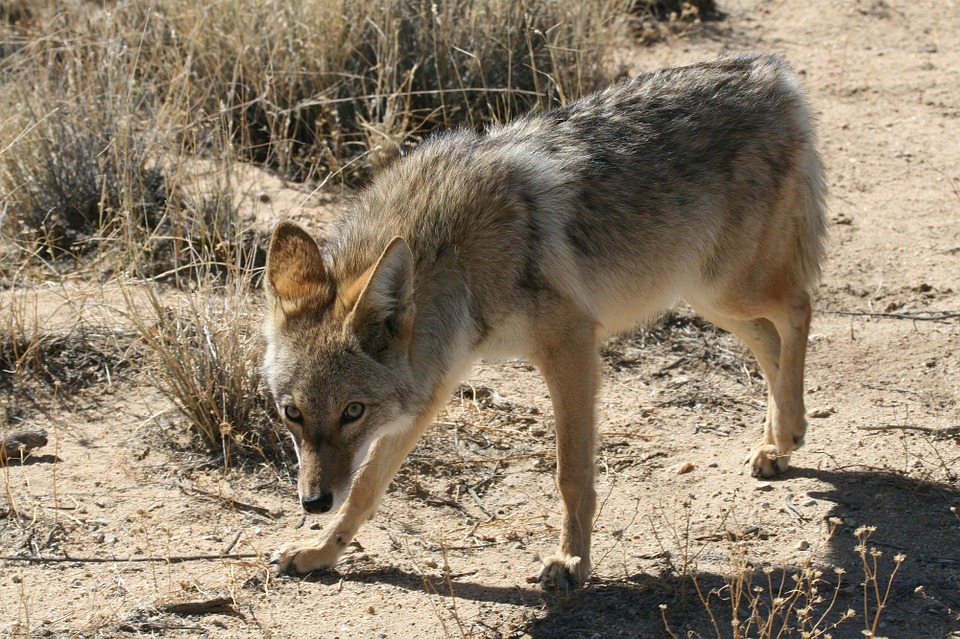Guide to Protecting Pets From Coyotes
Share

No matter where you live, you’ve probably encountered coyotes. This is why we wrote this guide for protecting pets from coyotes and other predators. Whether its porcupine, coyotes, bobcats, bears, or lions. We live in a world with a rapidly expanding human population. This means more houses, which means we are always infringing on wildlife’s resources.
We are very strong believers in maintaining a symbiotic relationship with nature, so it’s important to us that we raise awareness on the issue.
The question we get most frequently is how to deal with wild animals that threaten our dogs and cats, so we’re doing an entire section on how to live with wildlife. Here’s how you can keep your pets safe from coyotes…
Protecting Pets from Coyotes
In order to keep your pets safe from coyotes, you must first understand coyotes. This sums up the situation pretty well:
Coyotes are opportunists. They prefer to scavenge for food and are not picky about what they eat. They rarely attack prey larger than themselves and they will not take too much of a risk or waste too much energy on a meal.
Coyotes (and other wildlife) prefer “easy prey.” Like it or not, your small dog or free-roaming cat is a no-effort dinner for coyotes.
This is not true in all cases, as some coyotes are becoming increasingly adept at surviving in the city. But the general rule is that they prefer easy prey and anything you do to make your pets more difficult to hunt will help increase the odds of their survival.
Never Run Away from Coyotes
If you run across a coyote on a walk, do not run away. Prey runs away. Fellow predators hold their ground. But, don’t try to pet a coyote, either. These animals are incredibly intelligent and have even accused of “luring’ animals from their humans.
Hazing
Hazing is the act of making life uncomfortable for the coyote when he comes to visit. This helps remind coyotes that they should fear humans – which helps them survive. There are many things you try for hazing:
- Yell loudly and make noise (whistles, bells, etc.) If a coyote has been hazed before, you may need to try another technique.
- Walk towards the coyote in an aggressive manner. If the coyote still doesn’t move or begins to act aggressively towards you, back away slowly and contact authorities.
- Use repellents: Water hoses, pepper spray, loud hiss noises (Pet Corrector is ideal)
In order for hazing to be effective, the coyote has to know the threat is from a human (don’t hide in your car while throwing things at the coyote).
- Hazing is most effective when it comes from multiple people on multiple occasions through a variety of techniques.
- Be consistent with hazing.
- Encourage neighbors to be consistent with hazing.
Here are some easy tips to make your home less attractive to coyotes:
Change Your Environment
 Check your Fencing
Check your Fencing
The most important thing you can do to protect your pets is to ensure your fencing is secure. Read this article about Fencing Solutions to Keep Dogs Contained. No matter what type of fencing you choose, plan to use coyote rollers if you’re in an area that has many coyotes.
Use Coyote Rollers
Coyote rollers are ideal for both keeping your dogs contained and keeping coyotes away. They work by eliminating any way for the coyote (or dog) to grip the top of the fence and pull themselves over. Here is an example of how they work:

While we recommend using a professional install, we do have some tutorials on how to install DIY coyote rollers. This can save you a lot of money if you’re dealing with a large yard.
Build a Secured Outdoor Enclosure
There are many easy ways to create an outdoor enclosure and your pet door should only open onto a fully enclosed area such as a dog kennel or fenced area. Be sure to keep this area completely covered – a coyote can easily clear an 6′ fence. This is especially important when sheltering small animals like rabbits, chickens or cats.
Learn more about Creating the Ultimate Cat Enclosure.
Keep Water and Food Sources Behind Fencing
Water sources include everything from ponds to birdbaths. This also includes pet food and water dishes, pools, and koi ponds.
While fences can’t keep coyotes out of your yard, most fencing with coyote rollers will be enough of a determent that your larger dog will not be in danger. However, this may not hold true for small dogs, cats, chickens or koi fish in ponds. Coyotes can easily scale tall fencing. Coyote rollers will help deter, but if you have small animals, they should not have outdoor access to anything but a large enclosure.
Keep food indoors and make sure you feed your pets indoors. If you care for feral cats, be sure that they have secure feeding areas that allow a two-way escape route. Here is some helpful information about Winter Caretaking of Feral Cats.
Clean up Trash
If you compost, use enclosed bins. Coyotes are opportunists and rotting garbage is quite inviting. Keep all trash cans tightly contained with tight-fitting lids. If you have a trash pickup service that arrives on specific days, avoid taking cans out to the road too early the night before. It’s best to wait until morning.
Regularly rake areas around bird feeders to avoid attracting coyotes. Birds, squirrels and mice are easy prey for a coyote. When you feed birds or squirrels, you create an easy and convenient hunting area for predators.
Utilize Hazing Techniques
Hazing is another non-lethal way to keep coyotes out of your neighborhood. A more in-depth look at coyote hazing can be found here (this link will open onto a pdf file that you can print out).
Hazing primarily consist of utilizing loud noises, spraying water from a hose, using bright motion-activated lights. Even loud shouting is a great way to repel coyotes.
We have a large koi pond and like to put up these solar-activated predator control lights. They are quite effective in keeping coyotes and other smaller predator (like racoons and skunks) out of our yard. They are also quite useful for placing around chicken coops.
Make Your Pets Inaccessible
One of the most important things to do to protect your pets is revoke any possible coyote access to them. Microchip or ultrasound operated pet doors ensure that a coyote can’t follow your dog or cat into the house. They are a bit more expensive, but well worth avoiding a vet bill.
Avoid letting pets out in yard during early morning and late afternoon: This is the hunting time of crepuscular (active at dusk and dawn) animals. This by no means your cats and dogs will not be attacked, it only helps decrease the likelihood. Never depend on “timing” for your pets safety.
Only allow pet doors to open onto an enclosed section. Utilizing a cat-fence or safety netting can save your pet’s life. Learn how you can easily build safe Outdoor Enclosures for Cats and Dogs.
Keep collars on your pets
Coyotes attack by seizing an animal’s throat, 
Spiked collars have been used for centuries to protect pets from wildlife and are much more than a fashion statement. In fact, there are many Advantages of Spiked Collars. If an attacking animal is met with a mouthful of spiked metal, they are far more likely to move onto easier prey. Wide, heavy collars also serve the same function as animals can’t suffocate or feel their prey’s pulse as easily.
Coyote jackets have also proved effective in some cases. These jackets contain spikes or long wires that protect their back and neck areas. These are also quite effective on walks!
Coyote Repelling Technology that Works
Remember that before using any of these items, you need to consider your own pets and your neighbors pets. Never direct these at domestic animals as it can create some serious behavior problems. Always use repellent technologies safely and responsibly.
Nite Guard Solar Predator Control Light:
Solar Powered Nite Guard Solar uses sunlight or daylight to charge. No batteries are ever needed. It will continue to activate during long periods of cloudiness. The powerful flash of red light produced from this LED system will automatically activate at dusk and will force all night animals to flee the area. Based on scientific research, Nite Guard Solar emits a flash of light implying to all animals that hunt or feed at night that they have been “discovered” or are being watched.
HavAHart Critter Ridder: The sprinkler combines a surprise spray of water with unexpected motion and noise to create a safe, effective deterrent to unwanted visitors, helping keep your garden looking its best.
Ultrasonic Pest & Animal Control Repeller: This is one we haven’t personally tried, but there are over 500 excellent reviews at the time of this writing!
Bell Warning: This is used for deer, but we’ve heard that it works well for coyotes as well. The unit produces two separate and unique frequencies through air flow activation to protect against vehicle-animal collisions. However, it can also be used in yard.
Stay Safe On Walks
When walking your pets, be sure to carry a loud noisemaker such as a whistle, shaker can or air horn. We prefer the easily carried can of Pet Corrector, which creates a very loud hiss and is incredibly effective at scaring off any animal. Sounding these devices could save your pet’s life should you run across a coyote, moutain lion or bobcat.

Interesting Facts About Coyotes
Coyotes get a bad rap, but we urge you to understand the value they bring to our lives. Coyotes play an important role in maintaining healthy ecosystems and naturally control other species, including mice and other rodents.
Did you know that coyotes mate for life? It’s true.
Shooting coyotes result in more coyotes: Using a lethal means of control often result in even more coyotes. The coyotes tend to
Before you classify them as big bad wolves, consider that an adult coyote generally weighs about 20 lbs. They require relatively small amounts of food to survive and most do survive on berries and small field mice – especially in the desert.
Despite their small size, an adult coyote can easily scale or jump an 8-foot fence. When planning your fencing solutions, keep that in mind. Block walls work as a type of “super highway” to them. In Arizona, many of the homes in residential subdivisions have block walls. Using coyote rollers and other technology can help decrease the chances of your pet disappearing.
Usually, coyotes are quite shy and present a minimal risk to humans. However, as we infringe on their territories and steal their water sources, they become more desperate.
Coyotes are crepuscular (most active between dusk and dawn), but you will likely see the urbanized coyotes at any time of the day. These are incredibly intelligent animals and will often observe human activity from what they perceive to be a safe distance. They are curious, clever, and adaptable.
Coyotes quickly learn to take advantage of any newly discovered food source. This includes fruit and nut trees. They are often attracted to yards with birdfeeders, ponds and other easy stores of food.
Why Killing Coyotes Result in More Coyotes
Shooting coyotes lead to an increase in their population due to several ecological and behavioral factors:
1. Compensatory Reproduction
When coyote populations are reduced through lethal means, the remaining coyotes often respond by reproducing at higher rates. Females may have larger litters, and more young coyotes survive to adulthood due to reduced competition for resources. This phenomenon, known as compensatory reproduction, can quickly replenish or even increase the population.
2. Disruption of Social Structure
Coyotes have complex social structures that include territorial packs. Removing individuals through lethal control disrupts these structures, often leading to an increase in breeding pairs. When the dominant pair is removed, subordinate coyotes may start breeding, leading to more litters within the same territory.
3. Immigration
When a territory is vacated due to the removal of coyotes, it often becomes an attractive area for other coyotes from surrounding regions. These new coyotes move in to take advantage of the available resources, leading to an influx of new individuals and a quick rebound in population.
4. Increased Food Supply
With fewer coyotes in the area, the remaining coyotes or new immigrants face less competition for food. This abundance of resources can lead to better health and higher survival rates for the remaining population, contributing to faster population growth.
5. Short-Term Population Control
Lethal control methods often provide only short-term population reductions. Coyotes have high reproductive rates and adaptability, which means that their populations can quickly recover from reductions. This often necessitates ongoing lethal control efforts, creating a cycle of killing and population rebounds.
These factors combined mean that lethal control methods can lead to an increase in coyote populations rather than a decrease. This is why many wildlife management experts advocate for non-lethal methods of control that focus on coexistence and prevention of conflicts rather than attempts at eradication.
Are Coyotes Legal to Hunt?
I’m not going to answer that because killing coyotes is not the answer. You don’t get to whine about coyotes if you moved to an area to be “closer to nature.” Nature is beautiful, but it’s the raw beauty that draws us to it.
The more we infringe on their territory, take their water supply and diminish their prey, the more they will be forced to enter our neighborhoods. Whether you like it or not, predators play an important role in nature. Remove them, and you throw a delicate system off balance.
Brutality is occasionally a part of that beauty. Like the coyote, we need to learn to adapt to our new environments and learn to live peacefully with the wildlife that resides there already…











